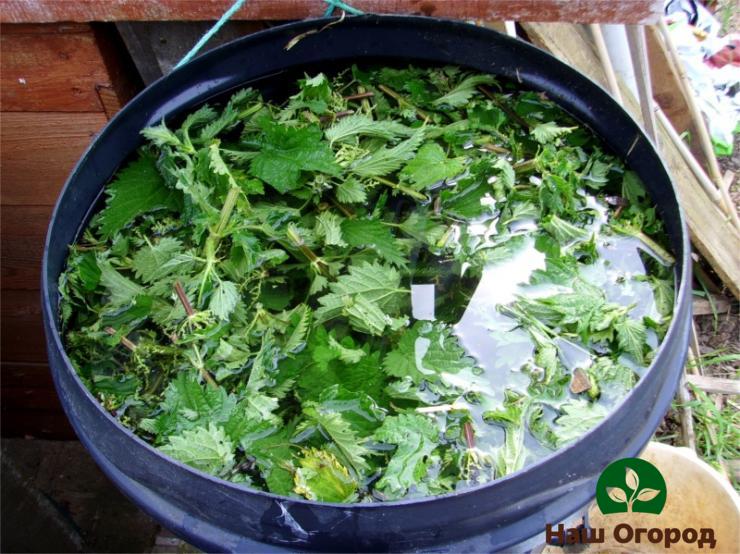Secrets of the prickly garden beauty-nettle
Content:
Nettle properties
Gardeners - supporters of organic farming, try, if possible, to exclude the use of chemical insecticides and fungicides on their plots. And, in order to prevent the infection of plants with various diseases, the treatment of which is possible only with chemical preparations, they are engaged in the prevention of infections using infusions of plants with appropriate fungicidal properties. These plants include nettles, which appear in large numbers in the spring in our areas.
However, in addition to phytoncides that kill and suppress the growth of harmful bacteria, nettle contains substances necessary for the development, maturation, improvement of fruiting, flowering of many plants, including: calcium and magnesium, which are necessary for the process of photosynthesis, the lack of which leads to a slowdown in plant growth. and their death; potassium, which activates the action of molecules responsible for the metabolism of nutrients; iron, manganese, silicon; vitamins A, K, E, B; organic acids.

It should be noted that the rich chemical composition of nettle has a healing effect on the human body. Decoctions of nettle are recommended for use with digestive problems. Infusions help to strengthen the immune system and improve metabolic processes. Ointments relieve muscle pain.
Nettle is also known as one of the constituents of hair and face skin care products.
And green cabbage soup with sorrel and young nettle is a tasty remedy for winter beriberi. Our ancestors, who know the value of this plant, even celebrated the holiday “Martha - green cabbage soup” on May 16.
Nettle as fertilizer
For feeding garden crops, an infusion of nettle is used, which is extremely easy to prepare. The stems and leaves of the plant are crushed and poured into a plastic container, filling it by 2/3, after which warm water is added to the top, covered with a lid and placed in a warm place for 2 weeks. During this time, the mass must be stirred periodically. To accelerate the maturation of the infusion, the container can be exposed to the sun. When the mass darkens noticeably and stops foaming, the infusion is ready.

The fertilizer obtained in this way is diluted with water (1 part of the infusion to 10 parts of water) and the plants are fed, bringing under each from 0.5 l to 1 l. Such dressings are done every 2 weeks, mainly after rain or during watering of plants.
In order to prepare a real multivitamin fertilizer, chamomile, yarrow, mat-stepmother, burdock are added to the nettle infusion. It is also recommended to add ash (for 10 liters of infusion 1 glass) and bread
However, such organic fertilizer should not be abused, especially during the ripening period of the fruit. Otherwise, the plants will begin to actively increase the green mass, while reducing fruiting.
The resulting infusion can also be used in foliar dressing. For spraying the leaves, the present mass is diluted in a ratio of 1:20. It is enough to carry out such feeding once a month. It should be noted that spraying the leaves promotes the production of chlorophyll, which is also called "plant blood".
Infusion of young nettle perfectly stimulates root formation, therefore, before planting, you can soak bulbs, tubers, seedlings in it, and phytoncides contained in nettle also disinfect planting material.
In the care of flower crops, spraying with nettle infusion is used to combat aphids and as a means of preventing the appearance of powdery mildew. For these purposes, 500 g of fresh or 200 g of dry nettle is poured with 5 liters of cold water and infused for 24 hours.
Top dressing nettle is not shown to everyone
Many gardeners are unanimous in their opinion about the benefits of nettle fertilizer for most garden crops. Tomatoes, peppers, cucumbers, cabbage, strawberries will be especially responsive to such dressings.
For example, tomatoes, having received a fertilizer saturated with potassium, they will begin to actively grow, bloom and fill.
Cucumbers such top dressing will give strength, will contribute to early fruiting, and an improvement in taste.
Cabbage prefers nettle fertilizer with the addition of dandelions more.
Berriesthat need nitrogen and potassium contained in top dressing will grow better and bear more fruit.
Fruit grapes, adding such fertilizer to add sweets.
The exception is garlic, onions and legumes... Feeding these crops with nettles is contraindicated, since such fertilization will only inhibit their growth.
We plant in nettles
Tireless gardeners have found another option for using nettle - using it as a substrate for growing cucumbers, which at the same time serves as a fertilizer and a means of protecting against infections and pests.
Crushed nettle leaves are poured into the holes, sprinkled with earth on top and cucumbers are planted. Moreover, they do not use any fertilizers, only periodically scattering wood ash, beloved by cucumbers, around the bush.
This method, according to them, is very effective, guaranteeing the formation of a large number of ovaries along the entire height of the bush.
Such a huge number of useful properties of nettle, thanks to which this plant is used in many areas, will certainly allow you to endure one of its small drawbacks - pungency.

